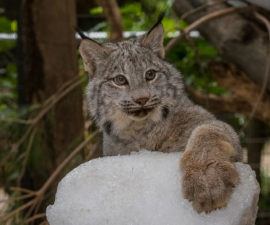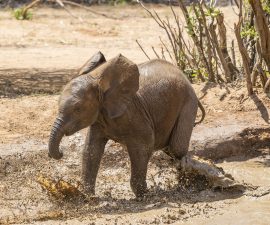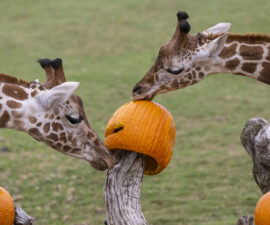Experienced Dad Steps in to Assist First-time Mom with Baby
A month-old duiker calf eagerly took a bottle from her keeper earlier today (Aug. 3, 2018) at the San Diego Zoo. Then the calf spent some bonding time with her mother and father. The female calf, named Etana (pronounced eh-TA-na, meaning Swahili for “strong one”), was born in an off-exhibit area of the Zoo’s Ituri Forest multi-species habitat on July 7, to first-time mom, Peep.
After giving birth, 5-year-old Peep was not properly caring for her calf. Unsure if Peep’s maternal instincts would kick in, the animal care team temporarily separated them and stepped in to give the calf bottle feedings, to ensure proper nutrition. That is when something out of the ordinary happened. The sire, 18-year-old Luke, showed attention and care for the calf, helping to demonstrate to the mother how to be a good parent. This is unique, since most male duikers do not play a role in parenting.
“Luke has sired six calves at the San Diego Zoo, so he’s not unfamiliar with having a little bouncing baby around,” said senior keeper, Jennifer Chapman. “He was a great catalyst to reintroducing Etana and Peep, showing Peep that the calf is an okay addition to their group. Peep is learning how to care for her baby and doing well,” added Chapman, “and Luke is always there, furthering the trio’s bond as a happy family.”
Keepers report the trio will continue to develop their relationships off-exhibit for the time being. The calf will then be introduced gradually to the multi-species exhibit the duikers share with the okapis. Zoo guests should be able to see the duiker calf in about two weeks, with her parents and the okapis in their habitat in Ituri Forest.
Duikers are small- to medium-sized antelopes native to sub-Saharan Africa. They are listed as Stable on the International Union for Conservation of Nature (IUCN) Red List of Threatened Species. Duikers are shy and elusive creatures with a fondness for dense cover. The name duiker (pronounced diker) comes from the Afrikaans/Dutch word for diver or diving buck. It refers to the duikers’ practice of diving into tangles of undergrowth. Duikers must always be on the lookout for danger, as they make a hearty meal for many predators. Female duikers are a bit larger than males, but both males and females have short horns. In the wild, duikers live alone, in pairs, or in small groups of between 3 and 10 animals.
Visitors to the San Diego Zoo may see the duiker trio in their habitat in the Ituri Forest in the near future. Those visiting the Zoo now through Sept. 3 can enjoy Nighttime Zoo, an annual summertime celebration that includes toe-tapping music, fascinating animal encounters, stilt walkers, exceptional acrobatic feats and African-themed music, dance, and more. The Zoo will stay open until 9 p.m., with special activities starting at 4 p.m. daily. Nighttime Zoo activities and attractions are free with Zoo admission or membership.





